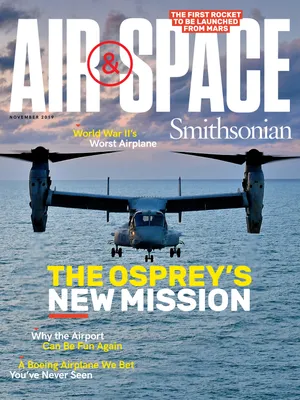What Goes Into Displaying a Supersonic Passenger Jet?
What it took to get the Concorde safely inside the National Air and Space Museum.
/https://tf-cmsv2-smithsonianmag-media.s3.amazonaws.com/filer/a7/07/a707e4c7-a03a-427b-b5db-c91cd49af4ac/concorde-letterboxed.jpg)
On its final flight, the Concorde hurtled toward its destination at Mach 2, while those on board leisurely feasted on caviar, rock lobster, and foie gras. When the aircraft landed at Washington Dulles International Airport, its flying career was over, but it was about to start a new journey, as part of the Smithsonian’s National Air and Space Museum’s collection.
It was June 2003, and the Museum’s Steven F. Udvar-Hazy Center was scheduled to open in just six months. When the Concorde arrived, it was the third aircraft waiting to enter the Hazy Center, along with the Boeing 367-80 (known simply as the Dash-80), and the Boeing 307 Stratoliner.
“We had set aside three weeks to defuel all three aircraft and move them into the building,” says Museum Specialist Rob Mawhinney. “And then we learned a hurricane was coming.”
In order to beat the hurricane, the Museum pulled in a new group of volunteers who were also United Airlines employees. A year earlier, Gary Berrian and his fellow employees were attending a United Airlines meeting at the Dulles Sheraton when they realized the presentation next door, which was about the new Hazy Center, sounded far more interesting. They crashed the adjacent meeting. “We asked how we could help,” says Berrian, “and we were put in touch with the restoration shop foreman. We ended up working on the Enola Gay.”
“About 20 of us from that project were asked to give the Museum a hand because of the storm,” says Berrian. “We defueled the Concorde on the ramp. But that aircraft is tail-heavy.” To keep the tail off the ground once the fuel was removed took some work. “We had to load 8,000 pounds of sandbags into the forward baggage compartment. These were 40-pound bags—you can do the math,” says Berrian.
Some 200 sandbags later, the Concorde was towed into the Museum, where the volunteers added even more ballast. (The sandbags are still there, but the Museum has plans to eventually remove them, when it attaches a cable to the nose, applying 8,000-pounds of force.)
All of the aircraft at the Hazy Center are displayed in an environmentally stable environment with a temperature of 70 degrees Fahrenheit and 50 percent relative humidity, says Robert van der Linden, a curator in the aeronautics department. “The Concorde is not illuminated from the inside, so there are no electrical considerations,” he says. “All of our aircraft are mounted on steel support stands that take the weight off of the tires. And the compression struts of the landing gear are locked into place so that if a shock absorber fails, the aircraft will not drop.”
The Concorde was placed so that visitors standing on the upper mezzanine walkway can look down and see all of the fuselage. “It’s a bigger aircraft than most,” says Mawhinney. He should know: Along with other workers, Mawhinney hand-polished the entire aircraft. “Because of all of the time it had spent at airports, the paint was oxidized and there were jet fuel stains all over it,” Mawhinney recalls. “We couldn’t do a machine-polish since it was inside; you’d end up spraying polish all over everything.” It took a week for the crew to finish the task. “We’d do three or four square feet and take a break; do another three or four feet and take another break,” he says.
In 2010, Museum staff noticed that one of the Concorde’s compression struts was sagging. Berrian was called back in to help: He’d left United Airlines and had gone to work for British Airways, and had continued to volunteer at the Museum.
The Museum’s Concorde was the first production Concorde delivered to Air France, and had spent 17,824 hours in the air. Preserving the crown jewel of supersonic transport: Just another typical day at the Museum.
